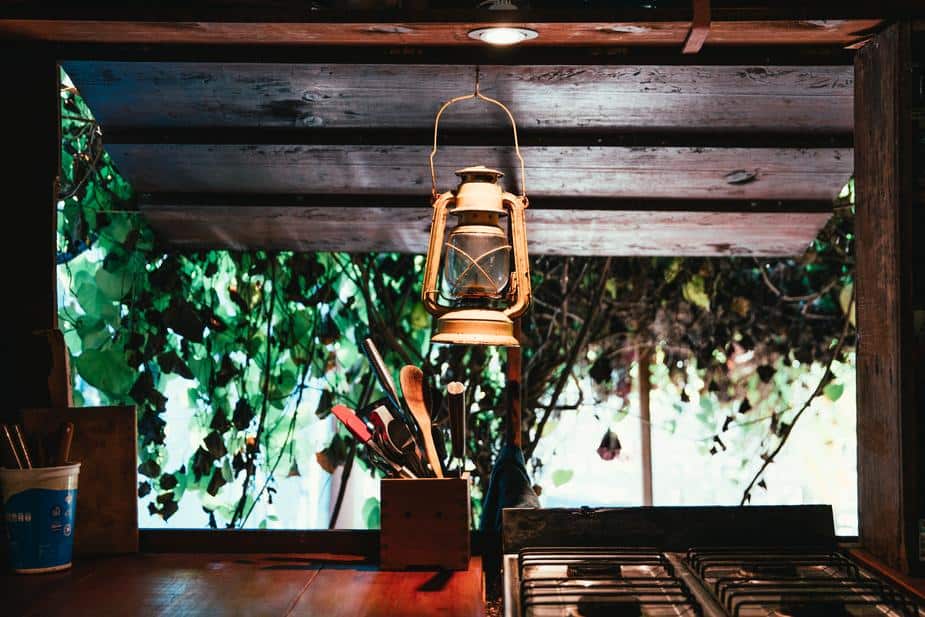A basecamp is a temporary shelter which can be used when waiting for the completion of your full cabin or, can be used during mountaineering expeditions. It’s just a place which you’ll temporarily call home. Though a basecamp is supposed to be simple, it can be a good idea to have a few luxuries which a cabin would have, in your basecamp.
The go-to luxury which I look for in a basecamp is a kitchen. Since the basecamp is temporary, I don’t build an extravagantly decorated kitchen, however I do look for a fully functional kitchen which I can enjoy cooking in. Even when staying in a temporary shelter, you don’t want to live like a caveman – it’s always great to have a few luxuries. In this article, I’ll be providing you with an extensive guide on how to setup a temporary outdoor kitchen for your basecamp.
Setup Enough Food Prep Space
A lack of preparation space can make preparing food very difficult. Therefore, it’s a good idea to set-up enough food preparation space. None wants to feel cramped, regardless of where they’re living. Too much room is better than too little.
When staying in an off-grid camp, it’s important to keep in mind that certain dishes will require different amounts of space to prepare. You’ll want to evaluate the amount of space which your preferred foods will take and ensure that you have enough room to prepare them. It may be crucial to sacrifice some foods which will require a large amount of speed to prepare. Despite this, you don’t want to sacrifice too much, as you still want to have an enjoyable stay at your camp.
I’m going to share a useful tip which I use in my temporary kitchens. Counters can be created from the heads of cabinets. Simply place your slap a butcher block on top of your
It’s important that you evaluate the layout of your kitchen. For my kitchens I always purchase covers to keep the furniture and appliances clean. Covering comes in specific sizes, and often the sizes are not too large, so you may have to purchase multiple to cover your entire kitchen. Because of this, you should plan your kitchen layout appropriately.
Include Appropriate Kitchen Storage
When setting-up your basecamp’s kitchen, it’s important to ensure that you have enough kitchen storage. I find that the more, the better.
Your kitchen will require lots of supplies such as towels, soap, chopping boards, different types of bowls, plates and eating utensils. Bare in mind that these will have to be stored in your kitchen and if you don’t have enough secure kitchen storage to keep them in when you leave your camp then they will have to be transported back and forth.
Having a lot of kitchen storage allows you to store a lot of these kitchens supplies and canned foods. This is useful as it means that you don’t have to carry a lot of kitchen supplies to your camp every time you visit it.
I find that large filing cabinets work well for kitchen storage. They’re perfect as they have wide draws which are great for storing supplies into. Make sure you purchase a lock for the cabinet so that you can lock-up all your supplies and keep them safe whilst you’re away.
I’d highly recommend that you only leave canned food at your basecamp. You don’t want to leave for weeks and have food spoil in your kitchen storage. Spoiled food will attract wildlife to your camp, this could lead to destruction. Imagine returning to your camp and finding everything knocked over and broken. Therefore, I only keep canned food in my temporary kitchen. You could also keep dry food if it’s locked in an air-tight container such as a zip-lock bag.
Purchase a Dutch Oven Table
If you don’t already have one, you’ll need to purchase a Dutch oven table. This is an essential piece of equipment in any outdoor kitchen. They’re perfect for slow cooking and baking in a Dutch oven. Dutch oven table make cooking in a Dutch oven a lot easier, removing the need to bend over excessively – making cooking a lot more comfortable and removing the risk of back injury.
I’d recommend this Dutch oven table. This is a great choice that will last you a long time if maintained properly. I’ve had mine for about a decade now and it’s still in great condition, ready to be used for many more years.
Purchase a Propane Stove
I feel as though every good outdoor kitchen should have a solid propane stove. I have an article in which I discuss the use of propane for cooking. There’s many benefits for cooking using propane which I mention in the article. I’d recommend the Camp Chef Explorer 2, it’s a great stove – designed for outdoor camping. This truly is an outdoor essential.
No matter where you are in the world, you should never have to sacrifice tasteful food. The propane stove which I’ve recommended is very versatile and works with a range of different accessories. This stove has very high-performance capabilities and a 3-sided windscreen to protect your food from the elements. Perfect size for a family and friends.
Outdoor Kitchen Sink
Now that you’ve set-up enough food preparation space, you’ve allocated sufficient kitchen storage, and you’ve also got some essential kitchen appliances; you’ll now need to consider your options for a kitchen sink. Having somewhere to wash your hands, dishes and eating/cooking utensils is vital to living hygienically.
You may be thinking that an outdoor kitchen sink may be a complex and expensive task but it’s not really. You can make it as basic as you want, depending on how much time and budget you have. I keep mine basic, and it’s doesn’t take effort very much at all.
If you want to know how I design my kitchen sink, I’ll walk you through the steps.
Firstly, I purchased a sink and counter combination. I got this for very cheap as it didn’t include any other hardware such as handles or faucets. It was simply the counter with the sink crater in the middle. I laid it between two cabinets to keep it up. I ensured that it was sturdy and secure (This is important as you don’t want your sink to collapse).
For a sink to function properly it needs water. There’s a few ways you can go about this, but I decided to have water come through a hose from a 275-gallon water tank. If you want to know more about the process, I explain it in-detail here. Essentially, I keep a water tank up a hill by my camp and have hose connected from the tank to the faucet. Bare in mind, for my kitchen sink – I don’t use drinking water; it’s just water for cleaning.
You may be wondering how I control the water flow. I attached a garden sprayer to the faucet and opened the water tanks valve so that I can control the faucet from the sink. Using the sprayer was very useful as it allows me to use the sink as if it was a fully functional sink that you’d have at home.
The water that goes into the sink is drained through a hose which leads to an uninhabited part of the forest. You could also have the water go into a nearby land of water – though I wouldn’t recommend this.
Outdoor Kitchen Drinking Water
You can use a similar method as above for your drinking water. Though if you’re storing large amounts of drinking water in a water tank/storage then you’ll have to treat the water regularly to ensure that it doesn’t spoil. For example, water must be treated to prevent the growth of algae. It’s common for water that’s been stored for a long time to become contaminated by bacteria and cause a strange taste.
There’s a simple method which you can use to kill any bacteria in your water storage. Simply, add a teaspoon of bleach for every gallon of water that you’re storing and mix it in. Let your storage sit for about 40 minutes before you use it. This will kill any bacteria in your storage and disinfect your water.
Personally, I find that storing large amounts of drinking water and having to treat the water is too much of a task. Instead I just bring water with me when I visit my cabin or camp. I’m a big fan of water dispensers. I fill up my water dispenser with some water every time I visit. I don’t use a fancy water dispenser with cooling, as I try not to use any electricity and I like to keep things minimalist.
If this doesn’t tickle your fancy and you’d prefer to store a large amount of water in a water tank, then I’d recommend you invest into a filtration system. I’d highly recommend this water filter. This product works wonders, filtering any water which you put through it.
Conclusion
If you feel as though I’ve left something out of this guide or you have any questions which you’d like to ask, feel free to leave a comment for me below. I’m always looking for ways to improve these articles and provide readers with the most quality possible.
My name is Eugene Thornhill. I'm an outdoor enthusiast who loves nothing more than being one with nature. I've lived in numerous outdoor homes and even constructed my own. Living off-grid is something I'm very familiar with, more so than living in the city. For many years I've dealt with the many problems of living off-grid. It's time to pass on my knowledge through Cabinguides.


